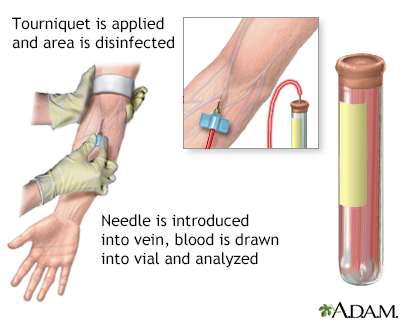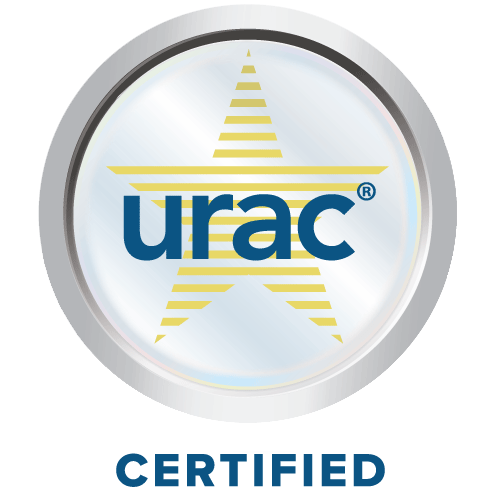25-hydroxy vitamin D test
25-OH vitamin D test; Calcidiol; 25-hydroxycholecalciferol test
The 25-hydroxy vitamin D test is the most accurate way to measure how much vitamin D is in your body.
Vitamin D helps regulate calcium and phosphate levels in the body.
Images

I Would Like to Learn About:
How the Test is Performed
A blood sample is needed.
How to Prepare for the Test
Usually, you will not need to fast. But this depends on the laboratory and the testing method used. Follow any instructions for not eating before the test.
How the Test will Feel
When the needle is inserted to draw blood, some people feel moderate pain. Others feel only a prick or stinging. Afterward, there may be some throbbing.
Why the Test is Performed
This test is done to determine if you have too much or too little vitamin D in your blood. Screening of all adults, even when pregnant, for low vitamin D levels is generally not recommended.
However, testing may be done on people who are at high risk for vitamin D deficiency, such as those who:
- Are over the age of 65 (both skin production of vitamin D and gut absorption of vitamin D becomes lower as we get older)
- Are obese (or have lost weight from bariatric surgery)
- Are taking certain medicines, such as phenytoin
- Have osteoporosis or thin bones
- Have limited sun exposure
- Have problems absorbing vitamins and nutrients in their intestines, such as those with ulcerative colitis, Crohn disease, or celiac disease
Normal Results
The normal range of 25-hydroxy vitamin D is measured as nanograms per milliliter (ng/mL) or nanomoles/liter (nmol/L). Many experts recommend a level from 20 and 40 ng/mL or 60 and 100 nmol/L. Others recommend a level from 30 to 50 ng/mL (75 to 125 nmol/L).
The examples above are common measurements for results of these tests. Normal value ranges may vary slightly among different laboratories. Some laboratories use different measurements or test different samples. Talk to your health care provider about the meaning of your specific test results, and whether you may need vitamin D supplements.
Many people are confused by the way these tests are reported.
- 25 hydroxy vitamin D3 (cholecalciferol) is the vitamin D that your own body has made or that you absorbed from an animal source (such as fatty fish or liver) or a cholecalciferol supplement.
- 25 hydroxy vitamin D2 (ergocalciferol) is the vitamin D that you have absorbed from foods fortified with plant vitamin D or from an ergocalciferol supplement.
- The two vitamins (ergo- and cholecalciferol) work similarly in the body. The important value is the total 25 hydroxy vitamin D level in your blood.
What Abnormal Results Mean
A lower-than-normal level can be due to a vitamin D deficiency, which can result from:
- Lack of skin exposure to sunlight, darkly pigmented skin, or consistent use of high-SPF sunscreen
- Lack of enough vitamin D in the diet
- Liver and kidney diseases
- Poor food absorption
- Use of certain medicines, including phenytoin, phenobarbital, and rifampin
- Poor vitamin D absorption due to advanced age, weight-loss surgery, or conditions in which fat is not absorbed well
A low vitamin D level is more common in African American children (especially in the winter), as well as in infants who are breastfed only.
A higher-than-normal vitamin D level (hypervitaminosis D) is most commonly caused by taking too much vitamin D. This can result in too much calcium in the blood (hypercalcemia). This may lead to many symptoms and kidney damage.
Risks
There is little risk involved with having your blood taken. Veins and arteries vary in size from one person to another and from one side of the body to the other. Taking blood from some people may be more difficult than from others.
Other risks associated with having blood drawn are slight, but may include:
- Excessive bleeding
- Multiple punctures to locate veins
- Fainting or feeling lightheaded
- Hematoma (blood accumulating under the skin)
- Infection (a slight risk any time the skin is broken)
Related Information
HyperparathyroidismHypervitaminosis D
Hypercalcemia
References
Bouillon R, Verlinden L, Carmeliet G. Vitamin D: from photosynthesis, metabolism, and action to clinical applications. In: Robertson RP, ed. DeGroot's Endocrinology. 8th ed. Philadelphia, PA: Elsevier; 2023:chap 50.
Markell M, Siddiqi HA. Vitamins and trace elements. In: McPherson RA, Pincus MR. Henry's Clinical Diagnosis and Management by Laboratory Methods. 24th ed. Philadelphia, PA: Elsevier; 2022:chap 27.
US Preventive Services Task Force; Krist AH, Davidson KW, et al. Screening for vitamin D deficiency in adults: US Preventive Services Task Force Recommendation Statement. JAMA. 2021;325(14):1436-1442. PMID: 33847711 pubmed.ncbi.nlm.nih.gov/33847711/.
BACK TO TOPReview Date: 5/20/2024
Reviewed By: Sandeep K. Dhaliwal, MD, board-certified in Diabetes, Endocrinology, and Metabolism, Springfield, VA. Also reviewed by David C. Dugdale, MD, Medical Director, Brenda Conaway, Editorial Director, and the A.D.A.M. Editorial team.

Health Content Provider
06/01/2025
|
A.D.A.M., Inc. is accredited by URAC, for Health Content Provider (www.urac.org). URAC's accreditation program is an independent audit to verify that A.D.A.M. follows rigorous standards of quality and accountability. A.D.A.M. is among the first to achieve this important distinction for online health information and services. Learn more about A.D.A.M.'s editorial policy, editorial process and privacy policy. A.D.A.M. is also a founding member of Hi-Ethics. This site complied with the HONcode standard for trustworthy health information from 1995 to 2022, after which HON (Health On the Net, a not-for-profit organization that promoted transparent and reliable health information online) was discontinued. |
The information provided herein should not be used during any medical emergency or for the diagnosis or treatment of any medical condition. A licensed medical professional should be consulted for diagnosis and treatment of any and all medical conditions. Links to other sites are provided for information only -- they do not constitute endorsements of those other sites. © 1997- 2025 A.D.A.M., a business unit of Ebix, Inc. Any duplication or distribution of the information contained herein is strictly prohibited.
